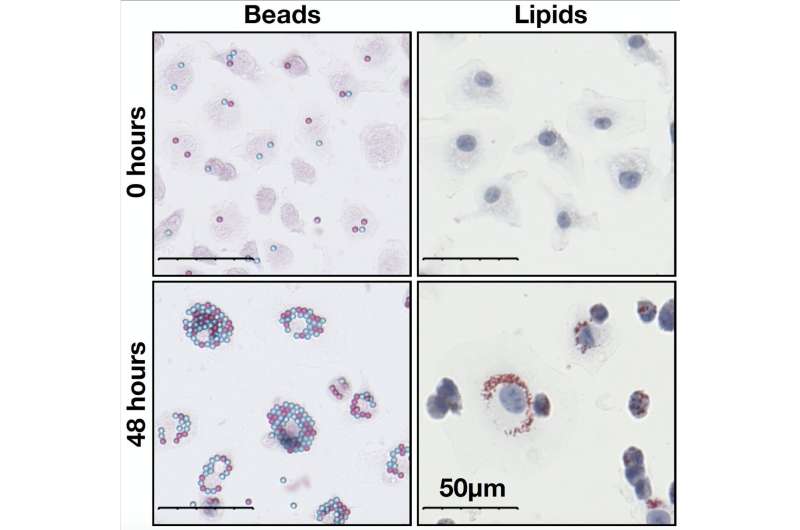'Cannibalism' is a double-whammy for cell health

Certain Inflammatory and infectious diseases, such as hardening arteries and tuberculosis, are caused by the build-up inside immune cells of harmful substances, such as cholesterol and bacteria. A study published today by University of Sydney researcher Hugh Ford has shown that these concentrations occur in part by virtue of cell cannibalism.
Published in Proceedings of the Royal Society B, Mr Ford's research shows that substances that transfer via cannibalism will concentrate inside the population via a coalescence process, where particles continually cluster into larger aggregates.
"Cell cannibalism has been an underappreciated dynamic in the development of inflammatory diseases," he said.
Mr Ford is undertaking his Ph.D. in applied mathematics at the University of Sydney and says his model, while applied in this instance to accumulation of cells, has broader implications.
"Our mathematical model shows that cannibalism has similar detrimental consequences in cells and in animals," Mr Ford said. "As with environmental ecosystems, cannibalism can transfer harmful substances between individual cells—or animals—and perpetuate disease transmission."
Mr Ford, working with colleagues at the University of Oxford, experimentally checked his model using mice bone-marrow derived macrophages (white blood cells) and how they form 'foam cells', which are the basis of arterial plaque in atherosclerosis, or hardening of arteries.
His supervisor is Professor Mary Myerscough from the School of Mathematics and Statistics, working in association with Professor Helen Byrne at the Mathematical Institute of Oxford. Professor Myerscough said: "Hugh's research has shown that the cannibalistic cells set up a 'double-whammy' for the build-up of harmful materials in the body.
"In the case of atherosclerosis, white blood cells that come to clear up cholesterol then die, leaving the LDL cholesterol in place, while adding their own cellular cholesterol."
Professor Myerscough said this leads to more white blood cells being sent in to clean up the mess, which in turn die, leading to an exponential build-up.
The problem escalates when normal processes that stimulate white blood cells to leave the tissue slow down or fail. Normally, these white blood cells, or macrophages, transport the dead materials into the lymphatic system. When this process breaks down, Mr Ford has developed a model that shows cell cannibalism contributes to the concentration of harmful materials in a cascading effect.
Professor Myerscough said that Mr Ford's study quantitatively considers cell emigration and brings this process into sharp focus.
Mr Ford conducted his research at the University of Oxford Mathematical Institute and the Sir William Dunn School of Pathology.
Principal Investigator Professor David Greaves from the Dunn School of Pathology at Oxford said: "Hugh's mathematical modelling allowed us to do a set of biology experiments that shed new light on the processes that drive diseases. Armed with these new insights we are keen to look for new drugs that enhance tissue protection by changing cell behaviour."
Mr Ford said the paper contributes to a growing body of evidence that casts cannibalistic cell removal as a double-edged sword.
"While on the one hand this process is crucial for tissue stability and the resolution of inflammation, it also perpetuates subcellular accumulation of harmful substances that can then contribute to the development of diseases, such as heart disease and tuberculosis," Mr Ford said.
More information: Efferocytosis perpetuates substance accumulation inside macrophage populations, Proceedings of the Royal Society B, rspb.royalsocietypublishing.or … .1098/rspb.2019.0730
Journal information: Proceedings of the Royal Society B
Provided by University of Sydney




















